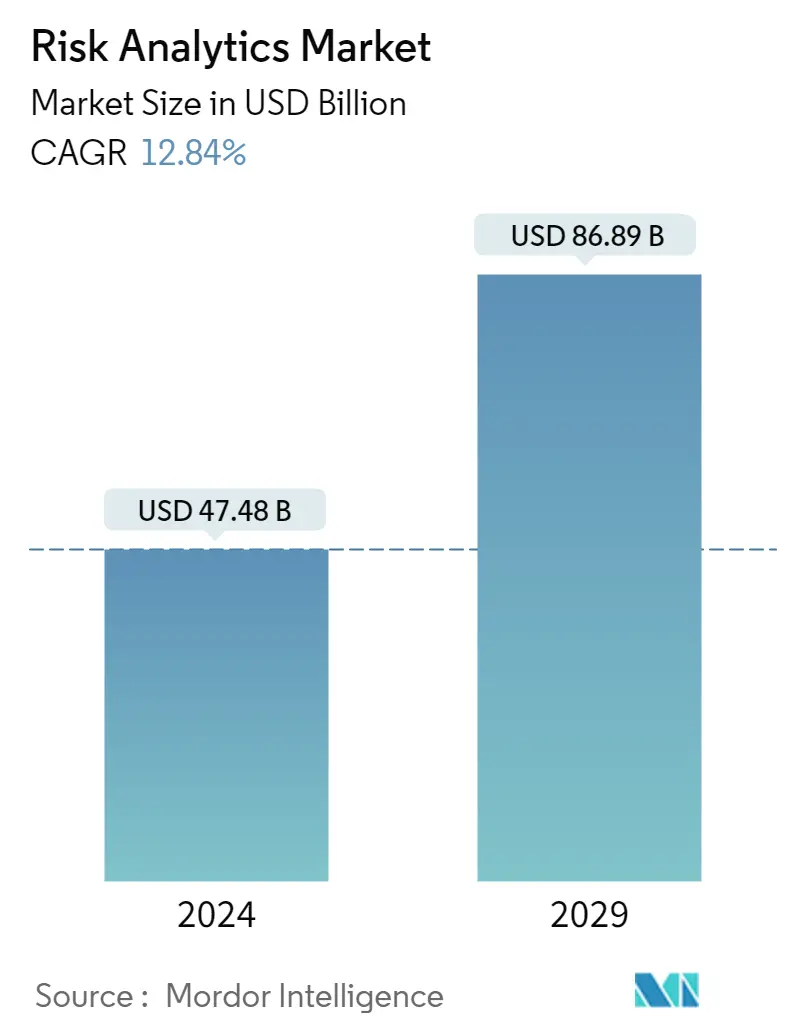Market Size of Risk Analytics Industry

| Study Period | 2019 - 2029 |
| Market Size (2024) | USD 47.48 Billion |
| Market Size (2029) | USD 86.89 Billion |
| CAGR (2024 - 2029) | 12.84 % |
| Fastest Growing Market | Asia Pacific |
| Largest Market | North America |
Major Players
*Disclaimer: Major Players sorted in no particular order |
Need a report that reflects how COVID-19 has impacted this market and its growth?
Risk Analytics Market Analysis
The Risk Analytics Market size is estimated at USD 47.48 billion in 2024, and is expected to reach USD 86.89 billion by 2029, growing at a CAGR of 12.84% during the forecast period (2024-2029).
Risk analytics solutions help organizations deal with and protect against operational risks, which can arise due to internal factors, such as human errors, failures of systems (which can be related to software, hardware, network, etc.), and fraud cybercrime.
- Currently, risk analytics techniques are enabling risk managers to measure and predict risk with more certainty than ever before. Organizations are leveraging risk analytics to gather supporting information through various security data sources to quantify their cyber risks, automate their security operations, and make intelligence-driven decisions. Additionally, organizations are witnessing increased regulatory pressure from the cyber perspective with mandates and guidance, such as the PCI-DSS and NIST Cybersecurity Framework.
- The increased usage of large amounts of structured and unstructured data in the various end-user industries boosts the demand for risk analytics to manage and save data from threats. For instance, According to Seagate Technology PLC, the global volume of data is expected to increase to 47 zettabytes and 163 zettabytes in 2020 and 2025.
- Moreover, cloud computing is driving a software revolution astonishingly as any other computing revolution of the past 40 years. As analytics for location-based risk advance, it is only sensible that they can be built and delivered using cloud-based technology rather than older server-based systems. There are several risk assessment and accumulation platforms available now through the cloud. Rules-based approaches to security, whether they are applied to threat detection, investigation, or response, can no longer keep pace with advanced cyber threats, including account compromise and malicious insiders.
- The demand for risk analytics in the banking, financial services, and insurance (BFSI) sector is also fueled by the increased use of mobile banking services and the rising volume of data. Risk analytics can be applied to combine the data into a single, comprehensive perspective, collect essential data, and produce insights that can be put to use. In addition, risk analytics are critical for logistics firms worldwide to efficiently address business disruptions and supply chain issues brought on by the spread of the coronavirus disease internationally.
- Furthermore, players cater to provide new analytics solutions, majorly in the healthcare sector, to combat COVID-19. Laboratory testing influences a significant percentage of clinical decisions and plays an essential role in improving care for patients with common, high-risk conditions. For example, LabCorp launched Insight Analytics reports that support provider organizations are delivering improved care, both individually and on a population level, for a range of high-risk health conditions.
